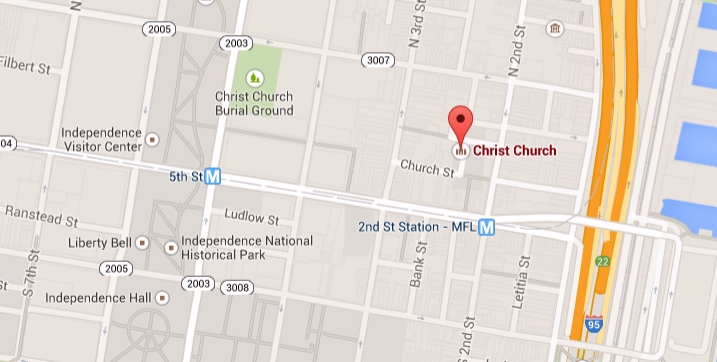
Christ Church, Philadelphia, PA
Benjamin Franklin was a great inventor. His inventions included everything from bifocals and swim fins to electricity. The place of Franklin’s grave is also the location where he is purported to have conducted the kite experiment — Christ Church in Philadelphia, PA.
“The experiment’s purpose was to uncover then unknown facts about the nature of lightning and electricity.
In 1752, Franklin proposed an experiment with conductive rods to attract lightning to a Leyden jar, an early form of capacitor.
Such an experiment was carried out in May 1752 at Marly-la-Ville in northern France by Thomas-François Dalibard. An attempt to replicate the experiment killed Georg Wilhelm Richmann in Saint Petersburg in August 1753, thought to be the victim of ball lightning. Franklin himself is said to have conducted the experiment in June 1752, supposedly on the top of the spire on Christ Church in Philadelphia.
Franklin realized the dangers of using conductive rods and instead used a kite. The increased height allowed him to stay on the ground and the kite was less likely to electrocute him. According to the legend, Franklin kept the string of the kite dry at his end to insulate him while the rest of the string was allowed to get wet in the rain to provide conductivity. A key was attached to the string and connected to a Leyden jar, which Franklin assumed would accumulate electricity from the lightning. The kite wasn’t struck by visible lightning (had it done so, Franklin would almost certainly have been killed) but Franklin did notice that the strings of the kite were repelling each other and deduced that the Leyden jar was being charged. Franklin reportedly received a mild shock by moving his hand near the key afterwards, because as he had estimated, lightning had negatively charged the key and the Leyden jar, proving the electric nature of lightning” — Wikipedia

Christ Church, Philadelphia, PA
Some of the famous people buried at the Christ Church burial ground:
Benjamin Franklin (1706-1790) Scientist, Philosopher, Printer, Diplomat, Signer of the Declaration of Independence and Constitution
Francis Hopkinson (1737-1790) Artist, Lawyer, Judge, Composer, Signer of the Declaration of Independence
Joseph Hewes (1730-1779) Secretary of Naval Affairs, Signer of the Declaration of Independence from North Carolina
George Ross (1730-1779) Judge, Signer of the Declaration of Independence
Dr. Benjamin Rush (1746-1813) Physician, social reformer, Treasurer of the United States Mint, Signer of the Declaration of Independence, founder of Dickinson College, Known as “The Father of American Psychiatry”
Sarah Knowles (1721) oldest known marker in the burial ground
Edward W. Clay (1799-1857) Political cartoonist
John Dunlap (1747-1812) Printer of the first broadside of the Declaration of Independence. Published the first daily newspaper.
Dr. William Camac (1829-1900) Prominent Philadelphia Physician who founded the Philadelphia Zoo, America’s first Zoo.
John G. Watmough (1793-1861) United States Congressman, who served as First Lieutenant in the War of 1812.
Major William Jackson (1759-1828) Revolutionary War officer, Secretary of the Constitutional Convention in 1787
Sarah Franklin Bache (1737-1811) Daughter of Benjamin and Deborah Franklin, Founder and member of “The Ladies’ Association,” which was a leading fund raiser during the Revolutionary War
Franklin Watkins (1894-1972) Served in the US Navy during World War I, Painter with artwork featured in museums around the world
Dr. Thomas Bond (1713-1784) Physician, founded the first hospital, Pennsylvania Hospital
Philip Syng (1703-1789) Silversmith and maker of the ink and quill stand used for the signing of the Declaration of Independence
Julia Stockton Rush ( 1759-1848) Wife of and daughter of signers of the Declaration of Independence, member of the Ladies’ Association
Dr. Philip Syng Physick (1768-1837) Known as the Father of Modern Surgery
Major General George Cadwalader (1806-1879) General during the Civil War
William M Meredith (1799-1873) Lawyer, State Attorney General, Secretary of the Treasury under President Taylor
Michael Hillegas (1729-1804) First Treasurer of the United States
Commodore William Bainbridge (1774-1833) Commander of Old Ironsides
John Spurrier (1746-1798) Author of the Practical Farmer, his book promoted the idea of composting
John Taylor (1718-1803) He was the gravedigger at the burial ground for over 50 years
Richard Folwel (1768-1814) Printer and newspaper publisher. He printed the first collection of laws of the United States, which was commonly known as the Folwel Edition.
Joseph Dolby (1741-1816) Sexton and bell ringer for Christ Church.
James Humphreys (1748-1810) Printer, who founded and published The Pennsylvania Ledger.
Richard Thomson (1799-1824) Consul from the United States to Canton
Back to the Greater Philadelphia Region | More Free Things to Do in Philly